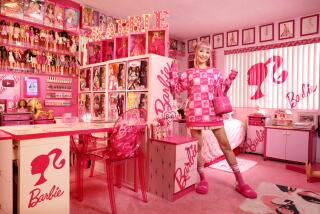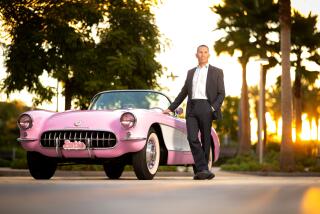Good Old Barbie
- Share via
LAGUNA BEACH — Don’t bad-mouth Barbie, at least not around Kitty Stuart. The self-described “radical feminist” has built a thriving business around the leggy, doe-eyed doll.
“I have a real hard time with people who don’t like Barbie, because I think she’s been a wonderful role model from the beginning,” said Stuart, who is relocating her Kitty’s Collectibles business from Colorado to Laguna Beach. “Throughout time, she’s been a teacher, an astronaut. . . . She ran for president a little while ago.”
Stuart can serve as a role model herself. The 45-year-old entrepreneur has created one of the nation’s largest vintage Barbie dealerships. She said her business will have at least $1 million in sales this year, largely from a mail-order catalog that generates orders from around the globe.
“I’ve done all this in five years,” said Stuart, whose success follows a circuitous career path that included acting, singing, selling houses and conducting self-improvement seminars for women. “Barbie is a $1.2-billion-per-year business. Every second, somewhere in the world, two Barbies are sold. It’s amazing.”
Her store, which will open in middle of this month, will feature a staggering display of dolls, clothing and accouterments, including dolls from Barbie’s “Golden Era” (1959-1972) and pint-sized ensembles with eye-popping price tags, such as Barbie’s $1,500 “Roman Holiday” outfit. Also in stock will be Barbie’s longtime boyfriend, Ken, as well as pals and relatives--Francie, Midge, Skipper, Allan, Tutti, Ricky and Skooter.
Laguna Beach resident Karen Norris, who is helping Stuart establish her new business and whose husband, Tom, is Stuart’s business manager, said she was amazed by the calls that began even before the moving vans arrived from Colorado. One woman rang from Germany with what sounded like a serious problem. She had a Barbie head and needed a Barbie body.
“I thought, ‘What is this, ‘Toy Story’?’ ” Norris said. “The collectors take themselves very seriously, and it’s a big dollar volume these people will spend.”
*
Indeed, the ranks of Barbie collectors are growing, said Karen Caviale, editor of Wisconsin-based collectors magazine Barbie Bazaar, which has seen its list of subscribers mushroom from 500 in 1988 to 90,000 today.
“The vintage business is very hot right now,” Caviale said. “Who knows how large it will get?”
Experts say the interest in Barbie collecting has broadened because the doll, who is 38 this year, is now wooing a third generation of girls and because El Segundo-based manufacturer Mattel Inc. launched a collector series in 1994 to entice adult buyers.
The collector Barbies have heightened interest in the vintage dolls, said Caviale, whose magazine is published under license from Mattel.
“All these people who specialize in vintage dolls, their business is booming because more and more people are getting into the vintage part of the hobby,” she said.
While Mattel is not involved in the secondary market, the company is protective of Barbie and her world-famous name. Last month, Mattel filed a lawsuit against Miller’s, another magazine for Barbie collectors, alleging trademark and copyright infringement. Mattel contends the quarterly publication is using the doll’s name and image without permission.
Dan Miller, who produces that magazine with his wife, Barbara, has said they will fight the suit.
*
Vintage Barbies cost from $85 to $13,000 and the outfits go for $5 to $3,000, said Stuart. In addition to selling vintage dolls and accessories, Stuart has assembled a private collection that she estimates is worth about $500,000.
“For a few hundred dollars you can start a beautiful vintage collection,” Stuart said. “Purchasing a $10,000 doll when you don’t really know if you’re going to be into this really isn’t that good.”
To bring top dollar, a doll or outfit must be “Christmas morning beautiful,” Stuart said. “The value is in having all the pieces and it being fabulous.”
Most highly prized are the NRFB--Never Removed From Box--items. A notch down in value are the MIB--Mint In Box--items that were removed, then returned, to their containers.
Sometimes the differences are subtle.
While a row of dolls made in successive years may just look like a blur of Barbies to the untrained eye, Stuart is quick to point out the differences, noting the black eyes and sharp arch of the eyebrows in the first and second versions and the blue eyes and paler skin in the third edition.
Barbie’s “Golden Era” between 1959 and 1972 was a time, Stuart said, when the dolls and clothing were manufactured in Japan and there was exquisite attention to detail. “They have like wonderful little zippers and little buttons.” she said.
The first five models--all with ponytails and curly bangs--came in striped swimsuits and black high heels. A Barbie from the “mod” era--1967-72--has long, straight hair and rooted eyelashes and may wear a miniskirt and go-go boots.
Boyfriend Ken also remained versatile over the years--donning swim trunks, hiking gear, business suits, a groom outfit and even a Beatle wig. But somehow, he never quite matched Barbie’s ability to dazzle or, for that matter, hold his value. A perfect Ken, for example, can command $50 to $150, Stuart said.
“Ken is like a lot of guys,” she confided, “a fashion accessory to Barbie.”
Males, however, are important to Stuart’s business. A sizable chunk of her customers are boys and men, she said. “A lot of men, now that they’re grown, are getting to have the dolls they never played with as kids,” she said.
One male client began collecting Barbies as a boy and kept them hidden so he wouldn’t be teased, Stuart said. He now has one doll worth $800 and a tiny mink coat valued at $1,000, she said.
*
Stuart’s love affair with Barbie began at age 7, when she received her first doll, a $3 toy that she said is now worth $900 to $1,000. If she had not removed the packaging to play with it, the doll would now be worth $1,500 to $2,500, she said.
She made fancy dresses for that early doll, and pillbox hats out of egg crates. “I thought that was so glamorous,” she recalled.
Stuart grew up in the San Diego area, where she lived with her mother, grandmother and two brothers. Due to family difficulties, Stuart said, she quit school in the eighth grade and took a job in a sandwich shop.
She married at 16, a union that lasted about three years and produced a daughter. By 19, Stuart was living in Los Angeles, where she launched an acting career. She had roles in about 15 films and a variety of television shows, Stuart said. She also sang in a band called Kitty Kitty.
Her acting career came to a halt, Stuart said, when at 25 she married Dwight Lyman Stuart, who was then president of the Carnation Co. The couple divorced in 1982.
“I left because I wanted to be my own person,” she said. “It was great that he was successful, but I wanted to be somebody in my own right.”
Her first business venture after that divorce--buying, remodeling and selling houses--was profitable until real estate sales cooled, she said. Drawing on her own experiences, she also began conducting seminars to help women develop careers and build self-esteem.
About six years ago, Stuart moved to Colorado in search of a stronger real estate market. But before moving, she took some dolls to a Pasadena doll show to see if she could sell them. She made about $2,000.
“I decided I should investigate that as a new business,” she said. Now, she and her fiance, Scott Randolph, sponsor Barbie shows throughout the country. When her Barbie business began to skyrocket, the other ventures were shelved, she said, at least temporarily.
Stuart buys many of her Barbies at the doll shows and also has a network of contacts around the globe who help her collect. In one case, a friend traveling in Africa found a cache of Barbie clothes in mint condition from the 1960s at a toy store that was closing. The friend snapped up the goods for Stuart.
“It was one of the finds of the whole Barbie world,” Stuart said. “Sort of like if they unearthed an Egyptian treasure. They unearthed a Barbie treasure.”
For Stuart, who moved to Laguna Beach earlier this year, the search continues.
“Any time . . . if I’m talking to someone, whether the girl at Denny’s or the girl at Saks Fifth Avenue, I’ll ask them if they have their old Barbies,” she said. “Either they or one of their girlfriends always has something, and I usually end up getting it.”
(BEGIN TEXT OF INFOBOX / INFOGRAPHIC)
Barbie Fun Facts
Introduced: 1959
Original price: $3
Current price: Average doll retails for about $10
1996 worldwide sales: $1.2 billion
International scene: American girls from 3 to 11 years old own an average of 10 dolls, compared to seven in Italy and five in France and Germany
Worldwide market: More than 140 countries
Wardrobe update: About 120 new outfits produced annually
Pets: Barbie has owned 17 dogs, 11 horses, five cats, a parrot, a chimpanzee, a panda, a lion cub, a giraffe and a zebra
*
Some Careers and Avocations
1959: Teenage fashion model
1960s: Ballerina, nurse, stewardess, astronaut, candy striper volunteer, student, fashion editor and teacher
1970s: Surgeon, Olympic downhill skier, figure skater and gymnast
1980s: Aerobics instructor, business executive, dress designer, television news reporter, veterinarian, rock star, UNICEF ambassador, Army officer, dancer
1990s: Pilot, diplomat, music video star, naval petty officer, Marine Corps sergeant, rap musician, roller-blader, chef, presidential candidate, pediatrician, dentist, paleontologist, medic, police officer, engineer, scuba diver, artist, baseball player, lifeguard and firefighter
Source: Mattel Inc.
More to Read
Inside the business of entertainment
The Wide Shot brings you news, analysis and insights on everything from streaming wars to production — and what it all means for the future.
You may occasionally receive promotional content from the Los Angeles Times.










